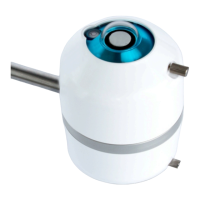EKO INSTRUMENTS CO., LTD. - Pyranometer MS-80/80S/80U - Instruction Manual Ver. 1
Pg. 33
6- 2. Calibration and Measu rement Uncertainty
It is recommended to recalibrate MS-80/MS-80S/MS-80U once every 5 years in order to verify the good quality of
the solar radiation measurements. In the following paragraph the calibration method of EKO pyranometers and their
calibration uncertainty is explained. For further information about recalibration and maintenance procedures, please
contact EKO or find on the EKO website [http://eko-eu.com].
EKO can offer calibration service for pyranometers and pyrheliometers in-house. Based on the applied calibration
methods EKO provides the best quality solar sensor calibrations compliant to the international standards defined
by ISO/IEC17025 / 9847 [Indoor method] and ISO9059 [Outdoor method] [Certification: L13-94-R2 /
www.pjlabs.com]
1. Calibration Method
MS-80 is calibrated indoors according to the ISO 17025 / 9847 international standard against a 1000W/m
2
AAA
class solar simulator radiation source and designated calibration facility.
Indoor Calibration Procedure
Both reference and field pyranometers are placed in horizontal position in the center of the light beam at equal
distance to the solar simulator light source. The pyranometers are alternatively exposed to the solar simulator beam
hence the output is measured from each pyranometer for a specified time. From the reference pyranometer output
[mV] and known sensitivity [μV//W/m
2
] the sensitivity figure [μV/W/m
2
] of the field pyranometer based on 10 data
samples can be calculated.
Measurement Uncertainty of Indoor Calibration
The calibration uncertainty of MS-80 can be kept below (0.7%) as stated in the scope of accreditation and stated
on each calibration certificate. Calibration in the lab is performed at a constant ambient temperature and ultra stable
light conditions. Hence the repeatability of the method and pyranometers under test can be well maintained. The
pyranometer calibration uncertainty is determined with consideration of uncertainty of the reference pyranometer
and maximum variation of incident light during the measurement of field pyranometer and reference pyranometer.
The expanded calibration uncertainty of each calibrated MS-80 model, and its results are stated on the calibration
certificate.
2. Calibration Traceability
The MS-80 reference pyranometer is traceable to the absolute cavity pyrheliometer maintained at EKO. The
absolute cavity pyrheliometer is directly traceable to the WRR [World Radiometric Reference] which is the Primary
Standard Group of Absolute Cavities maintained at PMOD (Davos, Switzerland). The logger system used for the
calibration measurement is traceable to JEMIC [Japan Electric Meters Inspection Cooperation].
Every year the MS-80 reference pyranometer is calibrated against the absolute cavity pyrheliometer, together with
5 other units part of the internal reference group of MS-80 pyranometers according the Shade / unshade Method
[Method for Calibrating Reference and Field Pyranometers (1995)] Bruce W Forgan]. During the IPC the EKO
absolute cavity is calibrated against the WRR every 5 years. Every year the EKO absolute cavity scale is examined
during the NPC at NREL (Boulder, USA).

